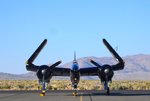Shortround6
Lieutenant General
Tomo, I still think the Grumman F7F might have been developed along the lines you indicated. It was introduced as a night fighter (F7F-1N) in small numbers (34) in 43-44. An upgrade to F7F-2N appears to have been produced in slightly larger numbers (65) in '44 thru '45. If the need to meet the specs you outlined had arisen in 1941, I expect a design similar to the F7F could have evolved to meet your performance specs or come close to them.
See the sizes of the bombs, adding 3-4in in different directions for clearance you need a bomb bay 11 ft long, 4 feet wide and about 2 feet high to carry four 500lb bombs in pairs behind each other or a bay just under 6ft long and 4 feet wide and four feet high. That is enough volume to house 720 gallons of fuel (thickness of self sealing not counted)
Bomb bay has to go about on the center of gravity. Or about where the F7F stored most of it's fuel. Granted you could stretch the fuselage 6 feet or so and by careful fuel management between fore and aft tanks keep the CG from getting to far out of wack (or move some fuel to the wings?
Is the F7F fuselage even 4 feet wide?
F7F single seaters carried 420 gallons of fuel. About 1/2 of what an A-26 carried and the A-26 has trouble meeting Tomo's range goal.

